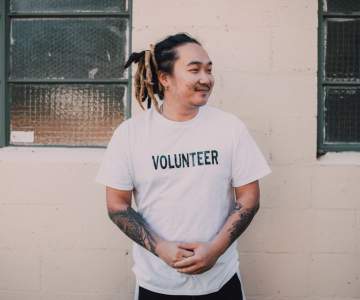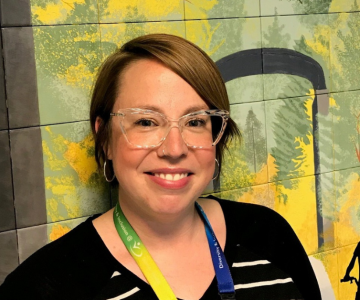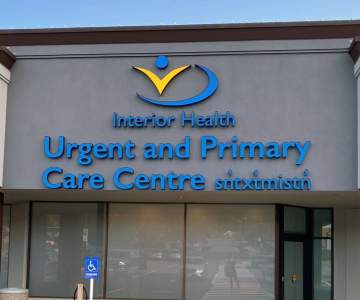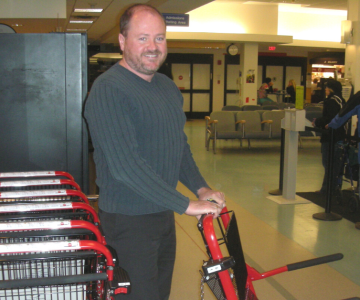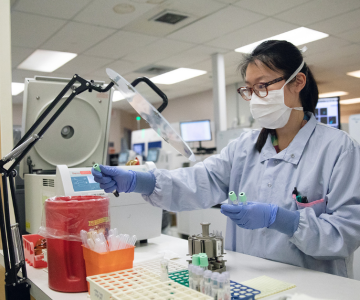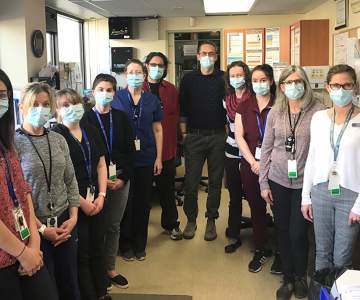Breadcrumb
Explore Stories
Community & Culture
Volunteers make an incredible impact across Interior Health.
Early in the pandemic, volunteer programs were temporarily suspended – and we missed you! For those whose role has changed, or perhaps even been put on pause while we respond to COVID-19, thank you for your continued support.
Starting mid-summer, volunteers were able to return to many Interior Health locations in limited ways. Even in smaller numbers, we are grateful for their support. Volunteers have also played key roles at immunization clinics, welcoming and supporting people arriving for their vaccine.
The Value of One, the Power of Many
Volunteers are a wonderful example of hope in a time of need. In some ways, the pandemic has motivated many more people across our region to contribute and to volunteer. Whether it’s Interior Health staff, community physicians and health care workers, local businesses or groups of citizens -- so many people have seen opportunities to make a difference.
Volunteers are our communities, our supporters and our connections. During a time when we have all been challenged – as family members, as friends, as colleagues – by working together we have persisted. You are welcomed, respected and valued members of the Interior Health care team. Thank you!
~ Susan Brown, Interior Health President & CEO
Thank you volunteers for inspiring us through your service.
Video file
Community & Culture
We are IH is a recognition campaign to spotlight Interior Health employees and medical staff – through pictures and stories.
Name: Michael-Ann Miller (She/Her)
Worksite: Princeton General Hospital
Ancestral Territory: "Syilx" (Saay-ilks) / Okanagan Interior Salish
Years of Service: 9
Job Title: Manager, Clinical Operations
"Fake it till you make it, it's all about confidence."- Michael-Ann's favourite quote
How many of us have thought of leaving behind the hustle-bustle of the city life, and reconnecting with Mother Nature in the tranquility of a small town? For Michael-Ann, a casual employee at a lower mainland hospital, this thought became a reality, but the turn of events that led here was not quite what she imagined.
A new mother, Michael-Ann returned to work following her maternity leave; soon after, her husband lost his job. Raising a family amidst the climbing costs of Vancouver was a definite challenge that needed an answer. This is when Princeton enters the story, a town in the Similkameen region of southern British Columbia, where the local hospital was hiring.
For anyone accustomed to the routine life of a metropolitan area, the concrete jungle becomes home. The very notion of moving to a smaller town can be daunting. Michael-Ann, too, was a little bewildered at the thought, but it turns out, she is now Manager of Clinical Operations at Princeton Regional Hospital and South Similkameen Health Centre in Keremeos!
“I fell in love with rural medicine. I had found my place. Being a generalist was my passion, and the variety of experiences and patient populations you deal with on a daily basis in a rural hospital is unlike any other area.”
Fast forward to her time after relocating to Princeton, Michael-Ann was able to buy a house, have another child, and her husband dedicate plenty of time to help to raise their children. She makes an accurate observation: “Only small-town living can afford you all these benefits on one income.”
Her flourishing career in rural medicine continues to inspire her today. She loves helping others and looks forward to sharing the beauty and complexity of rural health with the world. In her own words, the meaning of rural nursing is “being a generalist in a specialized world.”
Outside of work, Michael-Ann fulfills her creative side with some writing and enjoys spending time with her family. She has passions beyond rural health care, seeing that she was a former competitive swimmer and placed 11th in Canada!
Thanks, Michael-Ann, for all that you do!
Michael-Ann's nomination keeps the We Are IH loop going:
"Karen is a Registered Psychiatric Nurse, and in that role, she provides our community's most vulnerable with support and compassionate care. She is a strong advocate and always looking for opportunities to help out her community and strives for excellence in Mental Health and Substance Use. I have always appreciated her engagement and empathetic way of being that fosters client-centered care and collaboration within our team."
Stay updated with careers at Interior Health
Facebook: @IHJobs | Instagram: @InteriorHealthBC.Careers | LinkedIn: @InteriorHealthAuthority
Explore a Career at IH
Research & Innovation
Janet Costa and her husband Sam were vacationing in Mexico several years ago when Sam suffered a major heart attack.
He would be flown back to the Okanagan to be treated at Kelowna General Hospital, and thankfully would fully recover. The experience itself, however, awakened a new desire within Janet, to help patients better navigate the health-care system. Once the couple’s health scare was over, she found her way to volunteering with the Patient Voices Network and then applied to be on the Central Okanagan Patient Advisory Committee.
“Because I was a health-care worker before I retired, I knew who to call and how to access care for my husband,” says Janet. “But I thought, ‘what about other people who may not know how to navigate the system?’ That’s why I got involved.”
As a member of the Patient Advisory Committee, Janet and the other members engaged in planning for a number of initiatives, including the establishment of an Urgent and Primary Care Centre (UPCC) in West Kelowna, which opened in the fall of 2020. It was the fifth such centre to be opened within Interior Health, joining UPCCs in Kamloops, Kelowna, Vernon and Castlegar. A sixth has now opened in Penticton.
UPCCs offer urgent primary care—providing an alternative to using an emergency department when the patient doesn’t need emergency care. They also work to connnect patients to a family doctor or nurse practitioner, and offer services to under-served populations. UPCCs are tailored to best meet the population’s needs, as determined in collaboration with community partners such as physicians, health-care partners and patients.
In the planning stages for the West Kelowna UPCC, Janet and her fellow Patient Advisory Committee members had some recommendations.
“We thought it was a great idea,” she says. “People that work during the day and can’t get to their own doctors will still have access to health-care without having to go to the emergency room, which seems to be where people end up if these urgent centres are not available. We really wanted the centre to be available for under-served populations. One of our members had experience with people who were experiencing homelessness and knew what can happen to people in this population, so we wanted to make this very available for them as well.”
A team of general practitioners, nurse practitioners, registered nurses, social worker, physiotherapists and medical office assistants work together to support patient's care in UPCCs. The West Kelowna UPCC is expected to provide care for more than 27,000 patient visits annually.
“I think this is great,” says Janet of the addition of the addition of the West Kelowna UPCC to the area. “West Kelowna has gone a long time without something of this nature. I think it will be a huge boost to the community.”
Health & Wellness
In homes, schools, sports arenas and workplaces across our region, someone is missing.
Five years ago the increasing number of opioid overdoses prompted the Province to declare a public health emergency. Since then across Interior Health, more than 1,117* family members, friends, coworkers, teammates, neighbours and friends have been lost to overdose.
Much has been accomplished in these five years, but tragically this crisis continues.
Is there an empty chair in your life? A place that should be filled, but isn't, because of overdose?
We invite you to take a moment to remember loved ones lost, and those left behind, with our Virtual Memory Wall.
*BC Coroner's Service Drug Toxicity Report 2016 - 2021
Community & Culture
We are IH is a recognition campaign to spotlight Interior Health employees and medical staff – through pictures and stories.
Name: Ken Zarr (He/Him)
Worksite: Kelowna General Hospital, Okanagan
Ancestral Territory: "Syilx" (Saay-ilks) / Okanagan Interior Salish
Years of Service: 29
Job Title: Coordinator of Volunteers
"Happiness is temporary; joy is eternal."- Ken's favourite quote
Upon meeting Ken, you can feel his genuinely kind and welcoming energy. His friendly demeanour puts people at ease and creates a positive place for people to come together.
As an IH employee for over 29 years, in his current role as the Coordinator of Volunteers at the Kelowna General Hospital, his passion for helping others has positively impacted the lives of many. His unique ability to recognize the gifts that each person possesses and allow them to shine has played a critical role in his successful career. As an active member of his community, he works closely with others to help coordinate and fund important projects to improve the lives of others.
Prior to embarking on his career in health care in 1983, Ken’s career took him to many places, including living in Japan working in a steel mill and teaching English. He explored many career opportunities including radio broadcasting, communications, and computer programming. During this time he got married and raised three beautiful girls, including his step-daughter, and continued to explore different career paths including working in occupational therapy at Riverview Mental hospital, care aide, activity coordinator, funeral director, and traveling between Canada and California as a personal assistant.
Patti, Sue and Ken at a Volunteer EventOne of Ken’s proudest moments in his career was in his role as a Rehab/Activity/Volunteer Coordinator, where he raised funds to improve the facility, primarily in the Activity Department. This profound experience of seeing the Summerland community come together to support one another was inspiring for all.
More recently, Ken has a couple of other passion projects outside of work, including working as the President of Taco Dog Rescue Society for the past seven years, rescuing and rehoming many dogs from Mexico to the Okanagan, sometimes up to 10 dogs a weekend. There are many Interior Health staff members who are proud owners of these sweet pooches. If you’re looking to rescue a pup, learn about Taco Dog Rescue Society here.
Born in Kelowna and growing up primarily in Lavington, B.C., Ken greatly appreciates the beautiful scenery of the Okanagan, whether out hiking with his dog pack, or gardening with a focus on creative landscaping. When he isn’t playing volleyball or working out at the gym he is working on a fix and flip renovation project.
Looking forward, Ken and his second partner have opened up a Bed & Breakfast in Wilson’s Landing, steps away from the lake. After retiring from Interior Health in a few short years, he looks forward to working there, enjoying the water, and exploring the outdoors together. Thank you for all that you do, Ken! We appreciate you and all of our incredible volunteers throughout Interior Health.
Ken's nomination keeps the We Are IH loop going:
"I nominate Derek Koch, Spiritual Health Practitioner at Kelowna General Hospital. He cares about people; not just because it's his job. He is genuine, friendly, KIND, and always willing to make this place a better one. He works with staff, patients, and families in assisting with their special needs."
Stay updated with careers at Interior Health
Facebook: Interior Health | Instagram: interiorhealthbc
| LinkedIn: Interior Health Authority
Community & Culture
We are IH is a recognition campaign to spotlight Interior Health employees and medical staff – through pictures and stories.
Name: Pin Liao (She/Her)Worksite: Royal Inland Hospital, KamloopsAncestral Territory: Nlak a'p amux (Ing-k hla-k ap -muh) / Thomp son / Couteau Interior SalishYears of Service: 9 monthsJob Title: Medical Laboratory Technologist"Chance favours the prepared mind."- Pin's favourite quote
Pin's journey to her current role as a Medical Lab Technologist at Royal Inland Hospital for the past nine months is an inspiring story about dedication, courage, and a lot of hard work.
Born and raised in China, Pin grew up with an appreciation for experiencing different cultures, cuisines and meeting new people. Adventurous at heart, she has experienced many cultures as she traveled to the USA, Japan, Korea, Australia, France, and Switzerland. Inspired by a career where she could help people through science and research, Pin graduated with a major in Biotechnology. Determined to gain experience in the medical field, she worked as a Molecular Tech for a diagnostics company, testing patients' tissue slides or bone marrow to determine if targeted therapy drugs were a viable treatment plan.
Pin moved across the world to immigrate to Canada in 2017, where she attended the Medical Laboratory Technologist program in Prince George. Experiencing the coldest temperatures of her life, at -35 C, Pin was looking to start a family in British Columbia, leading her to her home in Kamloops.
Over the span of two years, Pin graduated, finished her practicum at Royal Inland Hospital, passed her Canadian Society for Medical Laboratory Science exam, and brought a beautiful baby into the world. Pin's strength, determination, and resilience shine through in all of her work, both in her personal and professional life. Grateful for a supportive family and co-workers at Royal Inland Hospital, Pin is proud of her incredible accomplishments.
Working in the Microbiology department at Royal Inland Hospital, the results that Pin reports on play a direct role in patients getting treatments. This leaves Pin with a sense of pride and motivates her as she reviews bacterial culture tests, knowing that patients are awaiting their results for treatment. The sooner the doctors get the results, the sooner the patients get the treatments.
As a fast-learner with a growth mindset, Pin is continually pushing herself to learn more and stay up to date with research. Excited to learn the latest research and techniques at the annual BC Society of Laboratory Science congress, Pin is looking forward to a future post-pandemic.
In the four-season playground of the Interior of British Columbia, there are many activities to experience, even amidst a pandemic. Her passion for exploring new places and her husband's love of the outdoors takes them to many local spots in Kamloops, whether out hiking at Sun Peaks or kayaking on the many beautiful local lakes. Pin loves listening to the Music In The Park in the summer at Riverside Park and discovering the delicious local cuisines that Kamloops has to offer.
We are so happy that your career brought you to Royal Inland Hospital, we appreciate you very much, Pin!
Pin's nomination keeps the We Are IH loop going:
"I nominate Dr. Gerald James. He is a Pathologist, with an easy-going personality, very knowledgeable, and willing to share his education and experience. Whenever he has an interesting case, he will sit down in front of the microscope and take time to share it with us. I feel like every time I work with him, I learn new knowledge from him."
Stay updated with careers at Interior Health
Facebook | Instagram | LinkedIn
Explore a Career at IH
Research & Innovation
If you ask Dr. Andy Hamilton, leadership skills should be taught to medical students and residents early on.
“In medical school, we train physicians to treat patients. We don’t train them to perform as part of a huge complex system and how to be effective in working within that system to make it better.”
Dr. Hamilton, a Yorkshire native who attended medical school in Manchester, never considered leadership back then. He chose medicine as a secure profession, and was drawn to anesthesiology because it combined practical skills, physiology and pharmacology. A residency at UBC led to 10 years at St. Paul’s and a stint there as acting head of anesthesiology. It was his move to Penticton Regional Hospital in 1999 that revealed his unexpected gift for leadership.
Penticton’s anesthesiology department only had a staff of four, and Dr. Hamilton quickly found himself nominated head of the department. Soon after, he became chair of the local medical advisory committee. Then in 2004, just after B.C.’s health regions were established, he sat on the Steering Committee reviewing surgical services for Interior Health, out of which sprang the BC Provincial Surgical Advisory Council (PSAC), which he co-chaired.
Leadership is about harnessing the expertise of others
The move prompted him to seek more formal leadership training, including the Innovative Leadership in Health Program from Royal Roads University, the Canadian Medical Association Physician Management program and certification as a Canadian Physician Executive. These courses endorsed his natural tendency to favour relationship-building as the best way to forge trust and encourage compromise.
Dr. Hamilton identified the highlight of his career as co-chairing the Provincial Surgical Executive Committee, established in 2014. Passionate about improving efficiency and access to surgery province-wide, he has always found it most effective to harness the expertise of others – physicians, nurses, other health care professionals, administration, health authorities and the ministry – and work together to achieve such goals as establishing a simple waitlist management system for surgery patients.
Dr. Hamilton believes that the quality of BC’s surgical services has improved dramatically over the last 20 years because of better-trained young physicians; more accurate measurements of surgical successes and outcomes, through innovations like the National Surgery Quality Improvement Program (NSQIP); and a transformed quality and safety culture. He’s particularly enthusiastic about the Surgical Safety Checklist, now standard procedure.
Everyone in health care has the opportunity to be a leader
One aspect of surgery that hasn’t developed quickly enough is access. Dr. Hamilton says transforming that demands a coordinated approach involving every element of surgical strategy, including human resources, IMIT, data collection and reporting, quality and governance. He says each B.C. health authority must examine its strategy, identify the barriers to access and eliminate them one by one.
Dr. Hamilton, a former Ironman competitor, retired in September, 2020, to a life of cooking, road-biking and travels with his wife, Meggie Ross, a public health nurse with Interior Health. Still a part-time anesthesiologist, he hopes to remain involved in surgery strategy.
“Everyone in health care has an opportunity to lead, whether it’s a physician or a housekeeper in the OR -- we all have a role to play, we’re needed in those roles, and we need to work together. We all stand to benefit from understanding the basic sciences around management and leadership, because that’s how we’re going to make the system better.”
This story was originally published by Doctors of BC.
Community & Culture
The KBRH pharmacy team (left to right): Carrie St.Onge, Gabrielle Deneault, Shelby Jorgensen, Amanda Cupello, Sheri Ford, Victor Ponte, Michael Conci, Alana Minty, Karly Lenardon, Margaret Horechka and Pam Caron.
As a student in UBC’s pharmacy program more than 20 years ago, Michael Conci worked at Vancouver General Hospital as a student pharmacy technician. It was his first experience working in a health-care facility and it struck a chord, igniting a passion for working in a hospital setting.
Having gown up in Rossland and with a love for the outdoors, Michael knew he wanted to return to the Kootenays after completing his schooling. As luck would have it, the hospital in Trail was hiring when he completed his degree, and he joined the pharmacy team at Kootenay Boundary Regional Hospital (KBRH) in 2001.
“I had gotten my dream job in an area where I loved to grow up and wanted to eventually raise a family,” says Michael, looking back on a long career that has grown along with his family, and the pharmacy that has become like a second home. “Trail is now home for my wife Amy (a Registered Nurse at KBRH), our three daughters and our chocolate Lab.”
With everything expanding in his life, it’s fitting that now the KBRH pharmacy will also expand to fit the needs of a department whose staff has doubled since Michael joined it. The pharmacy expansion and renovation is part of the ongoing redevelopment at KBRH with a $57.8-million dollar investment in two different capital projects.
A new emergency department opened at KBRH last fall, and construction is now underway on a new ambulatory care unit and the pharmacy renovation. The current project also includes enhancements to KBRH’s oncology unit, cast clinic, physiotherapy department and medical records area.
In the pharmacy, the footprint will increase significantly, allowing more space for the talented team of pharmacists and pharmacy technicians to work and ensure the “right medication gets to the right patient at the right time,” a mantra that the KBRH pharmacy team lives by.
Increased space means quieter places for the pharmacy team to work. Other pharmacy enhancements include new private space for patient counselling, industry-standard intravenous compounding suites and safe storage rooms.
The pharmacy team may be unseen by patients, but they will be working in a modern setting with upgraded technology to help support patient care. Pharmacists assist in developing a medication therapy plan for patients before pharmacy technicians work out a distribution plan so nurses can administer the proper medication. It’s a complex process with the safe distribution of medication the top priority.
The hospital pharmacy also distributes medication to outpatients in the community including to all oncology patients. Providing medications to patients allows them to recover at home and those arriving to pick up medications will be able to do so and talk with their pharmacist in a new private consultation area, once the project is complete.
For Michael Conci, the enhanced pharmacy will help support the great work that already occurs every day, supporting people’s health.
“I’m looking forward to having a space that helps our team fulfill its duties in a safe and effective manner,” he says. “Patients don’t often see the pharmacy team that is working hard to meet our vision of ‘caring for every patient through appropriate, timely and safe medication management.”
The project will complete in 2023.
Pharmacy facts:
• March is Pharmacy Appreciation Month, and the Canadian Pharmacists Association is celebrating the work of 42,500 pharmacists across Canada. Take a few minutes to learn more about what your pharmacist can do for you at rethinkpharmacists.ca.
• Along with KBRH, Interior Health has pharmacy renovation projects ongoing at hospital pharmacies at East Kootenay Regional Hospital in Cranbrook, Kootenay Lake Hospital in Nelson, Shuswap Lake General Hospital in Salmon Arm, Royal Inland Hospital in Kamloops and Penticton Regional Hospital.
Community & Culture
We are IH is a recognition campaign to spotlight Interior Health employees and medical staff – through pictures and stories.
Name: Donna MaatzWorksite: Swan Valley Lodge, CrestonYears of Service: 25Job Title: Long Term Care Coordinator"A still tongue makes a wise head."- Donna's favourite quote
As a dedicated employee of Interior Health for over 25 years, Donna has truly made an impactful difference in many lives.
Inspired by her mother, whom she recognizes as her hero and the most amazing nurse in the world, Donna followed closely in her footsteps. Her mother was a strong advocate for the intellectually delayed, inspiring Donna's career path to her current role as Long Term Service Coordinator at Swan Valley Lodge in Creston.
As an extremely caring and giving person, Donna takes pride in working in her hometown of Creston and giving to others in her tight-knit community.
Over the past 28 years as a nurse, Donna has lived through many health-care crises, including Anthrax, Ebola, and most recently, the COVID-19 pandemic. She expresses how challenging it has been working in long-term care amidst a pandemic, and sends her gratitude to all other health-care employees, from housekeeping, dietary, administration, nurses, physicians, care aides, respiratory therapists, physical therapists, occupational therapists, dietitians, porters, x-ray, ultrasound, imaging, lab, infection control, and all of the other incredible people who have been working around the clock to keep their communities safe.
Growing up on the ancestral territory of Ktunaxa Nation, nestled in the mountains of the Kootenay region, Donna is very close with her family. Her love of the outdoors extends past her love of swimming in the Kootenay Lake and Duck Lake to hiking, skating, sledding, camping, and fishing.
Raising her family in her hometown has been so rewarding with a bit of chaos. They lead a busy and fulfilling life, as between she and her partner, they have seven children, 23 grandchildren, many chickens, and pigs. Blessed with fertile growing land, Donna's passion for gardening yields tons of fruits and vegetables that can be enjoyed throughout the winter season.
Donna is looking forward to spending quality time with her friends and family when the pandemic is over. She keeps busy caring for her family, animals, and continuing renovations on her home. Her giving nature will continue to inspire her co-workers and community to help one another. Over the course of her successful career, she has shown so much compassion and dedication to Interior Health and her community. We are forever grateful for her long-term service and commitment that has positively impacted so many people. Thank you for all that you do, Donna!
Donna's nomination keeps the We Are IH loop going:
"Kendra, Manager of Swan Valley Lodge is one of the most compassionate leaders I have ever met! She is dedicated to staff and residents. She makes me want to come to work each day."
Stay updated with careers at Interior Health
Facebook: Interior Health | Instagram: interiorhealthbc
| LinkedIn: Interior Health Authority
-
Load More
Showing 639 of 796
Sign up for email updates
Receive news, alerts, public service announcements and articles right to your inbox.


